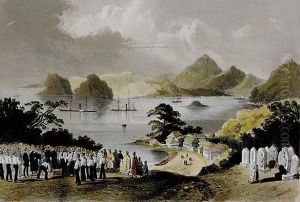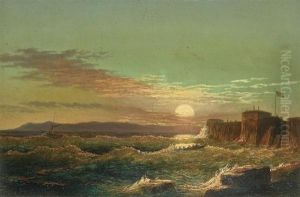William Heine Paintings
William Heine was a 19th-century German-American artist, best known for his work as an illustrator and painter. Born in Dresden, Germany, in 1827, Heine showed an early aptitude for the arts, which led him to pursue an education in this field. He studied at the Dresden Academy of Fine Arts, which was a leading institution in Europe at the time, and his training there provided a strong foundation for his later work.
Heine's career took a significant turn when he was chosen to be an artist for the United States Japan Expedition, also known as the Perry Expedition, from 1852 to 1854. This expedition, commanded by Commodore Matthew C. Perry, was a pivotal moment in history, as it led to the opening of Japan to the West after more than 200 years of self-imposed isolation. Heine's role was to visually document the journey and the various aspects of Japanese life and culture. His illustrations were later used in the official report of the expedition, which was published in three volumes titled 'Narrative of the Expedition of an American Squadron to the China Seas and Japan'.
After his work with the Perry Expedition, Heine settled in the United States. He continued his career as an artist, contributing to the landscape and genre scenes of American art. His experiences in Japan deeply influenced his artistic style, and he became known for his detailed and accurate representations of Japanese life, which were novel and fascinating to Western audiences at the time.
Heine's work was recognized for its quality during his lifetime, and he participated in several exhibitions. However, despite his contributions, he did not gain the same level of fame as some of his contemporaries. William Heine died in 1885, and today, he is remembered for his role in documenting an important historical event and for his cross-cultural artistic contributions that helped broaden the Western perspective on Japan.

